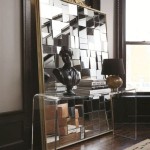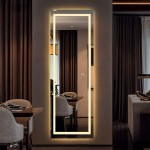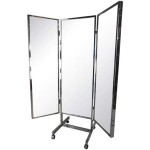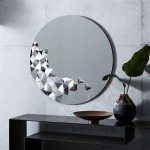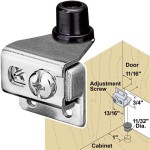Mirror Backsplash Tiles: A Reflective Choice for Kitchen and Bathroom Design
Mirror backsplash tiles offer a unique and versatile design element for kitchens and bathrooms. Their reflective properties can dramatically alter the perception of space and light, creating a sense of openness and brightness. This article explores the benefits, considerations, installation process, and maintenance of mirror backsplash tiles to inform design choices.
One primary advantage of mirror backsplash tiles is their ability to amplify natural and artificial light. In smaller kitchens or bathrooms, strategically placed mirror tiles can create the illusion of a larger, brighter space. This is particularly beneficial in areas with limited natural light sources. Reflecting light also distributes it more evenly throughout the room, minimizing shadows and dark corners.
Beyond their functional benefits, mirror backsplash tiles offer a range of stylistic options. Available in various shapes, sizes, and finishes, they can complement a diverse range of design aesthetics. Square and rectangular tiles offer a classic, clean look, while beveled or antique mirror tiles introduce a touch of vintage charm. Mirrored subway tiles provide a contemporary feel, while mosaic mirror tiles can create intricate patterns and textures.
The reflective surface of mirror tiles can visually expand a room, making it appear larger than its actual dimensions. This characteristic is particularly valuable in compact spaces where maximizing the sense of spaciousness is a key design objective. The illusion of depth created by the mirrors can transform a small, cramped area into a more open and inviting environment.
Before incorporating mirror backsplash tiles, certain practical considerations warrant attention. The reflective nature of mirrors can highlight imperfections on the wall surface. Thorough preparation and a perfectly smooth wall are crucial for a flawless finish. Any unevenness or blemishes will be magnified by the mirror, emphasizing the need for meticulous surface preparation.
Cleaning mirror backsplash tiles requires regular attention due to their tendency to show smudges and fingerprints. Using appropriate cleaning solutions and techniques is essential to maintain their pristine appearance. Gentle glass cleaners and microfiber cloths are recommended to avoid scratching the reflective surface. Regular cleaning will ensure the tiles retain their brilliance and contribute to a clean, polished aesthetic.
The installation process for mirror backsplash tiles is similar to that of other tile types. However, the reflective nature of the material requires extra care and precision. Using a high-quality adhesive designed specifically for mirror tiles is essential to ensure proper adhesion and prevent damage. Precise measurements and careful placement are crucial for achieving a seamless and professional-looking installation.
Consider the location and arrangement of mirror tiles to maximize their impact. Placing them strategically opposite windows or light sources can amplify natural light and enhance the sense of brightness. Using smaller mirror tiles in a mosaic pattern can create a visually dynamic and interesting backsplash. Larger tiles can create a more contemporary and streamlined look.
Combining mirror backsplash tiles with other materials can create unique and striking design combinations. Pairing them with natural stone, such as marble or granite, can create a luxurious and elegant aesthetic. Contrasting them with textured materials like wood or brick can add visual interest and depth to the space. Experimenting with different material combinations can result in personalized and visually appealing designs.
Mirror backsplash tiles are not suitable for all kitchen areas. Placing them directly behind the cooktop is generally discouraged, as they are prone to staining and damage from grease and heat. In high-traffic areas, the reflective surface can highlight splatters and require frequent cleaning. Careful consideration of the location and potential exposure to heat, grease, and moisture is essential when planning the installation of mirror backsplash tiles.
The versatility of mirror backsplash tiles extends beyond kitchens and bathrooms. They can be used in other areas of the home, such as dining rooms or living rooms, to create decorative accents and enhance the sense of space. Incorporating mirror tiles into furniture, such as cabinet doors or tabletops, can add a touch of glamour and sophistication.
When selecting mirror backsplash tiles, consider the overall design aesthetic of the room. The style, size, and finish of the tiles should complement the existing décor and create a cohesive look. Factors such as the color palette, lighting, and other materials used in the space should inform the choice of mirror tiles to ensure a harmonious and visually appealing design.
The reflective properties of mirror backsplash tiles offer a unique way to enhance the perception of space and light in kitchens and bathrooms. Careful planning, precise installation, and regular maintenance are crucial for maximizing their benefits and ensuring a long-lasting, visually appealing result.

Mirrored Herringbone Backsplash Tiles Tile Design Mirror

3x6 Wide Beveled Subway Antique Decorative Mirror Tile Backsplash Sold By Piece

20 Kitchen Backsplash Ideas That Won T Go Out Of Style Anytime Soon Mirrored Tile Unique Mirror

Beveled Paris Gray Hexagon Polished Glass Tile

3x6 Beveled Mirror Subway Tile In Paris Gray Tilebar Com

Mirrored Mosaic Backsplash Tile Design Ideas

Mirror Picket Style Tiles Contemporary Kitchen Renovation Cuisine Tuile De Dosseret Contemporaine

Antiqued Mirror Diamond Pattern Kitchen Bar Backsplash Tiles Design Ideas

25 Modern Kitchen Ideas With Mirror Backsplash

3x12 Beveled Antique Mirror Glass Subway Tile With Free On Qualifying Orders

